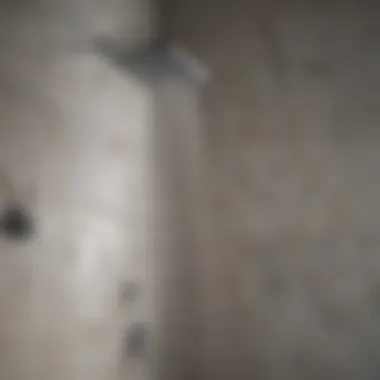Essential Guide to Bathroom Shower Equipment


Intro
In today’s home improvement landscape, the significance of bathroom design has skyrocketed. Of all the elements that can elevate a bathroom, the shower equipment stands tall among its peers. Homeowners are increasingly seeking showers that blend aesthetic appeal with functionality, proving the importance of thoughtful choices in fixtures, technology, and overall design.
Shower equipment is more than just plumbing; it can dictate the ambiance of your bathing space, making it a sanctuary after long days. With the plethora of innovative products and styles available, understanding what's out there can greatly influence the overall vibe of your bathroom.
This guide takes a closer look at essential shower equipment components, focusing on the latest trends and practical tips that go hand-in-hand with design inspirations. It's not merely about what fits; it's also about what feels right. Whether you’re planning a full renovation or simply upgrading a few fixtures, we've got you covered.
Design Inspirations
Latest Trends in Bath and Bedroom Design
Current trends in bathroom design are reshaping how we view shower equipment. Homeowners are gravitating toward a more spa-like experience. Here are several key trends:
- Rain Showerheads: These have gained immense popularity. They mimic falling rain and provide an immersive experience.
- Smart Showers: With tech becoming more prevalent, smart showers allow users to control water temperature and flow through apps or voice commands. This kind of innovation caters especially to tech-savvy homeowners.
- Open-Concept Showers: This design creates a seamless look, giving a feeling of spaciousness. Glass walls or partial enclosures are common here.
- Natural Materials: Using stone or wood can harmonize the bathroom with the rest of the home, contributing to a more organic feel.
All these elements invite a sense of relaxation and serenity, turning an ordinary shower into a rejuvenating experience.
Color Palettes and Themes
Choosing the right colors can dramatically influence the mood of your bathroom. Some suggestions include:
- Soft Neutrals: Shades like beige, gray, or soft white create an airy feel, making the space appear larger and more inviting.
- Bold Accents: Incorporating colors like navy, emerald green, or deep burgundy can add a touch of luxury and make your shower the focal point.
- Earthy Tones: These colors, reminiscent of nature, create a calm environment. Think terracotta tiles or olive-green fixtures.
Remember to consider your overall bathroom aesthetic when selecting your color scheme. Making informed choices here is crucial; it’s not just about what looks good but also how it fits into the bigger picture.
"A well-designed bathroom reflects personal style and adds value to the home."
Functional Elements
Space Optimization Tips
In smaller bathrooms, effective space utilization can be a game-changer. Here are three effective strategies:
- Corner Showers: Installing corner showers can free up floor space, allowing for a more open room.
- Niche Storage: Recessed shower shelves can be a tidy way to store accessories without taking up valuable space.
- Sliding Doors: Using sliding instead of hinged doors can create more usable space in tight areas.
These choices improve the user experience, making day-to-day routines more efficient and enjoyable.
Multi-Functional Furniture Choices
When upgrading bathroom equipment, opt for pieces that serve multiple purposes. Some suggestions include:
- Vanities with Storage: Look for designs that offer under-sink storage without sacrificing style.
- Foldable Hangers: Install foldable hooks for towels to maintain a tidy appearance.
- Shower Benches: These can enhance comfort and also serve as a place to store shower accessories.
By painstakingly selecting both style and function in your shower area, you foster an environment conducive to relaxation and rejuvenation.
Preamble to Bathroom Shower Equipment
When we think about our daily routines, showers often take center stage. A simple act of washing can be transformed into a moment of solace and relaxation, all thanks to the right shower equipment. This section delves into the fundamental aspects of bathroom shower equipment, shedding light on why it matters not just for functionality, but also for enhancing overall bathroom aesthetics.
Importance of Shower Equipment in Modern Bathrooms
The modern bathroom is no longer just a utilitarian space; it has transformed into a sanctuary—a personal retreat equipped with innovations that cater to comfort and efficiency. Choosing the right shower equipment elevates this space significantly. Here are some reasons why shower equipment matters:
- Functionality: Properly selected showerheads and valves create a more convenient experience, allowing for tailored water flow and temperature.
- Aesthetics: Distinct designs and finishes can enhance the visual appeal of the entire bathroom. From sleek chrome to rustic bronze, every detail matters in creating a harmonious look.
- Hydrotherapy: Certain shower systems can offer therapeutic benefits. Whether it’s a rainfall showerhead or a multi-function system, each experience can bring relief and relaxation.
- Eco-friendliness: Many modern options feature water-saving technologies, aligning with sustainable choices and helping to reduce domestic water consumption.
Just imagine stepping into your bathroom each morning, greeted by a perfectly regulated stream of water, tailored for your preferences; that’s the power of optimal shower equipment.
Historical Evolution of Shower Designs
Tracing the origins of shower designs reveals much about our evolving relationship with personal hygiene.
Historically, showers have morphed from communal bathing practices in ancient civilizations to the intimate stalls we know today. The ancient Greeks and Romans valued public bathhouses, partitioned spaces to cleanse and socialize. However, it was in the 19th century that private showers began to appear in homes, reflecting rising standards of personal privacy and wealth.
The technology continued to change, largely influenced by advancements in plumbing and heating systems. The fixtures evolved as well, introducing modern amenities such as:
- Mixing Valves: These allowed for better temperature control by mixing hot and cold water.
- Handheld Showers: Gaining popularity in the 20th century, they introduced flexibility and ease.
- Aerated Showerheads: These helped conserve water while maintaining pressure.
Today, the fusion of design and technology has brought about showers that not only fulfill primary functions but also serve as a highlight of bathroom decor. With options like smart showers and customizable features, the contemporary shower experience is centered on personalization and comfort.
Key Components of Shower Systems
Understanding the key components of shower systems is crucial for creating an efficient and enjoyable bathing experience. Each element plays a vital role in both functionality and visual appeal of your shower. By focusing on the various components, homeowners can make informed decisions that not only enhance usability but also elevate the overall aesthetic of the bathroom.
Showerheads: Types and Features
Fixed Showerheads
Fixed showerheads are a classic choice and are mounted directly to the wall or ceiling. Their simplicity is one of their standout features. They provide consistent water flow and are easy to clean and maintain. This type of showerhead is a solid option for anyone looking for reliability and ease of use. A common characteristic is the wide array of spray patterns available, from a gentle mist to a powerful massage. However, a fixed showerhead lacks flexibility, limiting the user's ability to direct water exactly where it's needed.
Handheld Showerheads


Handheld showerheads bring a touch of versatility to the showering experience. They are mounted on a sliding bar or a flexible hose, allowing users to easily adjust the height or even remove it for handheld use. This adaptability is especially beneficial for those with limited mobility, or for washing pets or children. A notable characteristic of handheld models is their diverse spray options, which can be changed on-the-fly. The downside might be that they require more cleaning due to their additional parts.
Rainfall Showerheads
Rainfall showerheads are known for replicating the soothing experience of standing in gentle rain. They are usually larger and mounted from the ceiling, delivering a soft, enveloping water flow. This choice transforms a regular shower into a spa-like retreat, contributing to relaxation and rejuvenation. The major advantage here is the immersive experience they offer. However, their larger size may not suit all bathroom layouts, and they can produce less forceful water pressure, which might not appeal to everyone.
Multifunctional Showerheads
For those who want the best of various worlds, multifunctional showerheads can be an ideal solution. These products often combine multiple spray settings—from a light drizzle to a focused jet—allowing users to customize their experience. Their adaptability makes them a popular choice among homeowners. However, the complexity of features can sometimes mean more maintenance and cleaning.
Shower Valves: Types and Importance
Pressure-Balancing Valves
These valves are critical for maintaining consistent water temperature and pressure. By automatically adjusting the flow of hot and cold water, they help prevent sudden fluctuations that might lead to uncomfortable or unsafe shower temperatures. This attribute makes them a popular choice for families with children, where temperature concerns are paramount. Still, if mismanaged, they may demand higher maintenance, which isn't ideal for every homeowner.
Thermostatic Valves
Thermostatic valves allow users to set a desired temperature, which keeps the water constant, regardless of fluctuations in water pressure. This type of valve offers ease of use and convenience, as users can enjoy a consistent shower experience. Their precision is unmatched, but the price point can be higher, which is something to consider when budgeting.
Digital Valves
Digital valves represent the latest in shower technology. With computerized controls, users can adjust temperature and water flow through a simple interface. This modern approach not only increases user convenience but can also integrate with smart home systems. As advanced as they are, these valves often come with a steeper price tag and can require more intricate installation.
Water Supply Components
Pipes and Connections
The pipes and connections in shower systems are the backbone of water delivery. Their primary function is to transport water from the source to the showerhead with minimal loss of pressure. Common materials include PVC, copper, and PEX, with each having its own benefits and drawbacks in terms of durability and ease of installation. Proper connections are crucial; failure here can lead to costly leaks, making needs careful consideration.
Water Filters
Water filters enhance shower experiences by ensuring that the water is free from impurities. This contributes not only to healthier skin and hair but also to maintaining the longevity of the shower components themselves. Filters can come in various forms, like handheld or in-line systems, but they require periodic replacements and cleaning to function effectively, which can be a hassle.
Flow Regulators
Flow regulators control the water pressure reaching the showerhead. They ensure a steady water flow and can significantly reduce overall water usage. This can be especially appealing to eco-conscious homeowners. However, these regulators might limit water flow during peak usage times—make sure this won't affect daily routines before selecting this option.
Ultimately, understanding these core components allows homeowners to select shower systems that align with their individual needs and preferences, ensuring a satisfying and tailored bathing experience.
Modern Innovations in Shower Technology
Modern innovations in shower technology have transformed the bathing experience, bringing a blend of comfort, style, and efficiency. As households increasingly seek to enhance their amenities, the advancements in shower systems are crucial not just for aesthetics but also for sustainability and user-friendliness. With these innovations, users can now enjoy showers tailored to their preferences while also being conscious of water conservation practices. New technologies are pushing the envelope, making showers not just a functional necessity, but also a lavish retreat.
Smart Shower Systems
Smart shower systems are at the forefront of these innovations. They offer unprecedented control and convenience, significantly enhancing how we enjoy our daily routines.
Voice-Controlled Showers
Voice-controlled showers symbolize the integration of convenience into daily life. These systems allow users to activate their showers through simple voice commands. This becomes particularly useful when your hands are busy, say, after a workout or while prepping for a quick shower. The key characteristic of voice-controlled showers is their intuitive interface. Whether you want to adjust water temperature or even switch on integrated features such as lighting and sound, a voice command does the trick.
While such showers are certainly beneficial, they do come with their own quirks. One notable advantage is connectivity; they can be integrated with other smart home devices. However, a possible downside could be privacy concerns, as the device’s listening feature may feel intrusive to some.
Temperature Control Features
Temperature control features in modern showers are another significant innovation. They provide consistent water temperatures, eliminating the common frustration of sudden temperature fluctuations. This ensures that your shower remains comfortable throughout the duration of your bath. The key characteristic here is precision; advanced thermostatic technology makes it easier to maintain a consistent, enjoyable experience.
Such systems are beneficial for families where multiple users might have different preferences. They can preset temperatures for individual users, giving everyone their perfect shower experience. On the downside, however, if users forget to adjust their settings, they might face water waste during longer showers.
Water Usage Monitoring
Water usage monitoring systems represent a shift towards environmental consciousness. These systems provide real-time feedback on water consumption, helping users to be more mindful of their usage. The key characteristic of these systems is their analytical prowess; they can inform you how much water you’ve used over time.
The benefit of this innovation goes beyond immediate user engagement; it fosters habits of conservation. Users can see their numbers and may actively seek ways to reduce consumption. However, a potential disadvantage is that some heavy users might feel judged by these systems. But awareness can lead to changes that benefit both the household and the environment.
Eco-Friendly Shower Solutions
Eco-friendly solutions not only enhance the experience but also align with the growing demand for sustainability in home improvements.
Low-Flow Showerheads
Low-flow showerheads are designed to reduce water consumption without compromising on water pressure. They achieve this by limiting the flow of water, allowing users to enjoy their showers while being eco-friendly. The key characteristic of these showerheads is their efficiency; they can cut water usage down by over 30% compared to traditional models.
Many choose low-flow showerheads not merely for their benefits to the environment but also for the cost savings on water bills. It’s a win-win situation. Yet, some users might feel that low flow equates to a lesser experience, but advancements in technology have successfully countered this notion, making them just as enjoyable as conventional models.
Water Recycling Systems
Water recycling systems capture and filter used shower water, allowing it to be reused for purposes such as toilet flushing or outside irrigation. The key characteristic of these systems is their dual-functionality—while giving users a refreshing shower, they are simultaneously contributing to water conservation in the broader scope.
Adopting such systems can drastically reduce overall water consumption in a household, proving to be both environmentally friendly and cost-effective. However, the initial investment and complexity of installation can deter some homeowners.


Incorporating Lighting and Sound
Innovations extend beyond just water usage; they also embrace ambiance through effective lighting and sound systems.
Integrated Lighting Systems
Integrated lighting systems in showers offer ambiance and functionality, allowing users to customize their experience. The key characteristic of these systems is their versatility; with options for various brightness levels and color temperature, showers can become soothing spaces tailored to personal moods or routines.
The benefit here is quite clear; lighting can enhance relaxation or energize, depending on the time of day and individual need. However, one must consider the maintenance of these systems, as water exposure may lead to challenges.
Sound Systems in Showers
Sound systems in showers provide a luxurious upgrade to the bathing experience. The key feature is connectivity; users can listen to music, podcasts, or even guided meditations directly from their showers. It transforms mundane routines into uplifting moments of enjoyment.
These systems become especially popular among younger users for their social and entertainment value, yet there may be concerns for others about sound quality or durability in humid conditions.
In today’s home, innovations in shower technology not only focus on functionality but also prioritize the user’s sensory experience, crafting a more enjoyable daily ritual.
In essence, these modern technological innovations significantly improve the shower experience by combining luxury with sustainability. Whether through a smart system that learns your preferences or eco-friendly choices that help save water, there’s a breadth of options to cater to every user’s needs.
Choosing the Right Shower Equipment
Choosing the right shower equipment is not just about splurging on shiny fixtures; it's about enhancing your daily routine and ensuring that your bathroom serves your needs efficiently. An appropriate choice can turn an ordinary shower into an invigorating experience, adding value and aesthetics to your home. Understanding various elements, benefits, and considerations is crucial in making informed decisions that reflect personal style and practical requirements, especially for homeowners and design enthusiasts.
Assessing Space and Layout
When selecting shower equipment, the space available and its layout should be your first consideration. Not all showers fit every bathroom design, and it’s vital to take accurate measurements. A compact bathroom might benefit from a corner shower or a sliding door for space maximization. Conversely, a spacious layout can leverage a luxurious walk-in shower.
Consider the following:
- Shower size: Ensure the chosen equipment aligns with both the physical space and your showering habits.
- Access: Evaluate the ease of entry and exit. A tight fit could lead to potential accidents.
- Flow: Plan how water will flow; avoid placing the shower in a spot that creates pooling.
The right layout can make your shower a sanctuary, a space that not only meets your needs but feels like a breath of fresh air.
Material and Finish Selection
The selection of materials and finishes in bathroom shower equipment should not be underestimated. Each choice of material brings its unique appeal, maintenance needs, and durability to the table. Let's delve into three common materials used in shower fixtures:
Stainless Steel
Stainless steel has become a staple in modern bathroom aesthetics, known for its durability and sleek appearance. One of its key characteristics is resistance to corrosion, which makes it an excellent choice for long-term use in humid environments like bathrooms. The ease of maintenance is another highlight; a quick wipe keeps it gleaming without needing harsh chemicals. In terms of disadvantages, it can be prone to scratches and fingerprint smudges, requiring regular upkeep to maintain its polished look.
Brass
Brass has a warm, classic vibe that many homeowners cherish. Its unique feature lies in its natural antibacterial properties, making it not just a pretty fixture but a hygienic choice as well. The advantages of using brass include its ability to withstand high temperatures and its relatively easy maintenance compared to other materials. However, brass may tarnish over time, requiring treatments to restore its shine.
Plastic
Plastic is favored for its affordability and lightweight nature. A standout characteristic of plastic is its vivid variety of colors and designs, offering customization to match any decor. It’s a practical choice for budget-conscious homeowners, providing decent durability against impacts. On the flip side, plastic may not have the same longevity as metals like stainless steel or brass and could appear less luxurious.
Budgeting for Shower Upgrades
When it comes to budgeting for shower upgrades, it’s like planning a dinner party—you have to know your guest list and how much you’re willing to spend on each dish. Start by setting a clear budget. Here are some areas to account for:
- Fixtures: Showerheads, valves, and filters can vary widely in price. Determine which features you desire.
- Installation: Will you tackle this as a DIY project, or will you hire professionals to ensure quality?
- Accessories: Don’t forget towels, bath mats, and other decor items that enhance the final look.
"A solid budget plan not only prevents overspending but also ensures you enjoy your new shower to the fullest."
Having a well-thought-out budget allows you to make informed choices that affix both value and joy to your bathroom experience.
Installation and Maintenance of Shower Equipment
When it comes to enhancing one’s bathroom experience, proper installation and maintenance of shower equipment cannot be overlooked. They are the cornerstones that ensure your shower functions as intended, providing both comfort and efficiency. Installing equipment correctly not just avoids potential issues down the line but also augments the longevity of the components. On the other hand, regular maintenance practices keep everything in tip-top shape, promoting water conservation and preventing costly repairs.
DIY Installation Considerations
Many homeowners might consider installing shower equipment themselves. While this can be rewarding, there are several factors to think about:
- Skill Level: Assess your own skills. Do you feel comfortable handling tools and plumbing fixtures? A minor mistake could lead to water damage or even personal injury.
- Time Investment: Installation might take longer than expected. If you’re working on your own, consider how much time you can realistically dedicate.
- Local Codes: Always check local building codes and regulations, as they can dictate how installation should be carried out and can even affect resale value later.
Taking on DIY sometimes is a can-do approach, but consider all the angles before diving in.
Professional Installation Options
Not everyone has the time or inclination for DIY tasks. Professional installations come with their own set of benefits:
- Expertise: Plumbers know the ins and outs of the job. They can handle complications that might arise during installation and ensure everything meets safety standards.
- Warranty: Many manufacturers require professional installation to maintain warranties. This extra layer of protection can be quite valuable.
- Time Efficiency: Professionals often complete jobs quicker since they’ve handled these installations numerous times, getting it right the first time without delays.
Choosing professionals can save you headache and provides peace of mind when upgrading your shower.
Regular Maintenance Practices


To keep your shower functioning smoothly, regular maintenance is crucial. A few key practices can greatly enhance the lifespan of your equipment:
Cleaning Showerheads
Cleaning showerheads might feel like a chore, but making it a habit can keep water flow consistent. Blockages due to mineral buildup can hinder water pressure significantly.
Key characteristics include:
- Simple Process: Most showerheads can be easily removed and soaked in vinegar to dissolve lime and calcium deposits.
- Consistent Pressure: Regular cleaning restores optimal flow, ensuring your bathing experience isn’t compromised by a trickle.
This practice increases shower efficiency, making it a wise and inexpensive investment of time.
Checking for Leaks
Leaks can be a sneaky problem that escalates over time, causing water waste and potentially leading to more severe issues.
Characteristics of this practice include:
- Early Detection: Regular checks allow for early detection, which can save you money and resources.
- Minimal Effort: A simple visual inspection around joints and connections can identify trouble spots before they become significant issues.
Incorporating this step can not only preserve your water bill but also enhance your home’s value through proper upkeep.
Inspecting Valves
Lastly, inspecting valves is a crucial aspect of shower maintenance that often gets overlooked.
The unique feature here is:
- Flow Control: Valves manage the temperature and flow of water, thus controlling your shower experience.
- Identifying Faults: Regular checks can reveal blockages or malfunctions early, preventing unexpected shower trouble.
Keeping a tab on valves can save you from cold surprises or frustrating leaks down the line.
"Proper installation and regular maintenance not only prolong the lifespan of shower equipment but also enhance the overall bathing experience."
Incorporating these strategies into your routine can be the difference between a blissful bathing experience and a frustrating one.
Trends in Shower Equipment Design
In contemporary bathroom remodeling, the focus on trends in shower equipment design reflects wider shifts in homeowner preferences and advancements in technology. Staying abreast of these trends can influence not only the aesthetics of a bathroom but also its functionality. Homeowners today seek spaces that not only serve a practical purpose but also offer a sense of serenity and luxury. As such, understanding these trends is essential for those looking to refresh their bathing space.
Trends in Aesthetic Choices
Minimalism
Minimalism has gained traction as a major aesthetic choice in shower design. This approach emphasizes clean lines and decluttered spaces, delivering a sense of calm. The main characteristic of minimalism is simplicity; every element has a purpose, creating an effect that is easy on the eyes. A shower system that embraces this design philosophy often features streamlined fixtures in neutral colors, focusing on the essentials.
Uniquely, minimalism encourages the use of high-quality materials such as glass and polished chrome, which can elevate the overall feel of a bathroom. The advantages of this design style include ease of maintenance; fewer nooks and crannies means less cleaning. However, for some, minimalism can feel stark or impersonal, so it’s a balance that needs to be struck depending on personal taste.
Industrial Style
Industrial style brings a different attitude to shower spaces, rooted in raw materials and an unfinished look. This trend relies on exposed plumbing, metal fixtures, and an overall rugged charm. The main characteristic of industrial style is its homage to factory aesthetics, bringing a touch of urban chic into the home. It is popular among those who appreciate a more robust and historic feel in their living spaces.
A unique feature of industrial design is its versatility; you can mix and match materials—think metal alongside reclaimed wood for a cozy yet edgy vibe. While this style contributes a strong personality to the bathroom, its downside can be functionality; exposed pipes might not appeal to everyone and could require more upkeep than sleek, hidden systems.
Biophilic Design
Turning to a more nature-centered approach, biophilic design integrates natural elements into shower spaces. This trend brings the outdoors inside, often through the extensive use of natural light, plants, and organic shapes. A key characteristic of biophilic design is its goal to improve mental well-being by creating a connection with nature.
Unlike other styles, a unique feature of biophilic design is the incorporation of living walls or materials that mimic natural landscapes. This choice is beneficial because it promotes relaxation and a sense of refreshment amidst daily stresses. However, it sometimes requires more thoughtful design and maintenance, particularly with plant care and water systems.
Color Schemes and Finishes
Choosing the right colors and finishes can make or break a shower design. Popular color palettes tend to include soft whites, earthy tones, and pastel shades that support the tranquil bathing experience. These choices not only affect the aesthetic look but also impact the perceived size of the bathroom. Lighter colors can elicit a feeling of spaciousness while darker shades can create a cozy, intimate vibe.
Different finishes ranging from matte to glossy have their unique effects as well. A matte finish, while trendy, is less forgiving with spots and water marks, whereas a glossy finish reflects light well, enhancing brightness in smaller spaces. The careful selection of both color schemes and finishes can result in a shower design that complements the overall bathroom persona, making it a truly refreshing retreat.
Ending
In the realm of bathroom design, the importance of shower equipment cannot be overstated. This article has traversed through the intricate details of various components, technologies, and emerging trends that altogether enhance functionality and aesthetic appeal. Understanding these elements is more than just a design choice; it shapes the daily routines and experiences of individuals and families alike.
Key Takeaways on Shower Equipment Selection
When it comes to selecting shower equipment, here are several vital points to consider:
- Assess your needs: Before diving into the myriad of options available, take a moment to reflect on how you use your shower. Are you after a quick rinse, or do you enjoy extended spa-like sessions? Understanding your habits helps streamline choices.
- Prioritize quality over price: It might be tempting to cut costs when buying shower fixtures, but investing in high-quality equipment pays off in durability and performance over time. Think about brass versus plastic; the former not only looks better but lasts longer.
- Consider space limitations: Not every bathroom can accommodate every type of shower system. If you have a compact space, a handheld showerhead might be your best bet, allowing flexibility without overwhelming the area.
"A well-chosen shower can completely alter the experience of a bathroom, transforming the mundane into a sanctuary of relaxation."
- Stay updated on innovations: With technology always evolving, it’s smart to keep an eye on new innovations. For instance, smart shower systems might add convenience, allowing for personalized experiences with just your voice.
- Plan for maintenance: While it’s easy to focus on the beauty of a shower system, don’t forget the upkeep involved. Regular maintenance checks—cleaning showerheads, inspecting valves, and looking for leaks—are essential to keep everything running smoothly.
Future Directions in Shower Innovations
Looking ahead, shower innovations will continue to blend functionality with comfort and sustainability. Here are a few anticipated directions:
- Integration of smart technology: This trend is set to skyrocket. Features like water usage monitoring and temperature control through apps will likely become the norm, making showers efficient while providing a highly customized experience.
- Sustainability focus: With a growing emphasis on eco-friendliness, expect to see more products designed to conserve water and energy. Innovations like advanced low-flow showerheads will not only be more economical but also address environmental concerns.
- Personalization: The future may see showers that can adapt to individual preferences. Customizable features like adjustable lighting and sound systems integrated into your shower space may soon be standard, enhancing the bathing experience.
- Materials and finishes: As the market evolves, we might witness a shift toward innovative materials, enhancing durability and aesthetic appeal. Advances in finishes could lead to surfaces that resist tarnishing and maintain their luster longer.
In sum, the bathroom shower equipment landscape is poised for change, and engaging with these emerging technologies will significantly impact how we experience the fundamental act of bathing. Taking the time to understand these trends will ensure that when it comes to your own space, you can create not just a shower, but an experience.















